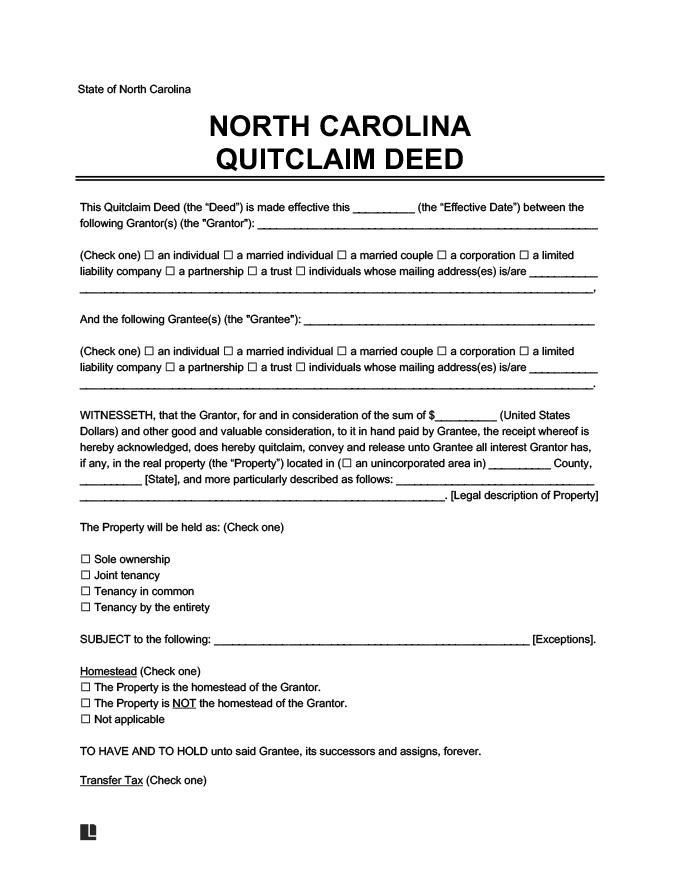A North Carolina quitclaim deed transfers property from one party, known as the grantor, to a second party, referred to as the grantee, without issuing any warranty regarding the quality of the title on the property. That means that the new owner of the property will assume any risks related to the title, including liens or encumbrances.
Because of the potential for title problems, quitclaim deeds are typically used to transfer property between entities that know and trust one another, including family property transfers and the transfer of real estate between companies under the same umbrella.
Legal Framework
Relevant Statute
N.C. Stat. § 47 covers the details of North Carolina quitclaim deed requirements and those of other types of deeds.
Signing Requirements
According to N.C. Stat § 47-38, a notary must acknowledge the grantor’s signature in order for the quitclaim deed to be valid.
Recording Requirements
N.C. Stat. § 47H-2 requires quitclaim deeds to be recorded with the register of deeds in the county where the property is located.
Transfer Tax
North Carolina assigns a transfer tax of $1 per $500 of property value, as per N.C. Stat § 105-228.30.
Validity Requirements
In order to be considered valid, a quitclaim deed in North Carolina must meet specific standards. First and foremost, it must note that the deed transfers the title but does not include any warranty on the title. Any mention of a warranty, general warranty, or special warranty should be avoided in creating a quitclaim deed. Furthermore, it should meet the formatting standards laid out in N.C. Stat § 161-14, including:
- Standard size or legal size paper (8 1/2 x 11 inches or 8 1/2 x 14 inches)
- Black ink only, with printing on one side of the page
- Handwritten text completed in pen
- Fonts no smaller than nine points, with many counties preferring 10-point font or better
- A 3″ margin on the top of the first page
- 1/2″ margins on the rest of the page or pages
- A clear title that identifies the document as a quitclaim deed
By following North Carolina quitclaim deed requirements, which can be managed easily by using a quitclaim deed template specifically for the state, both grantor and grantee can feel confident that the property transfer will go through correctly and that the recorder of deeds will accept the document.
Content Requirements
A North Carolina quitclaim deed must contain essential information about the property and both the grantor and the grantee, including:
- The name and address of the grantor (the original owner of the property)
- The name and address of the grantee (the new owner of the property)
- The legal description of the property, which includes not only its address but also the boundaries and other information laid out in the title
- The name of the party that prepared the deed
- A statement about whether the property is the grantor’s primary residence
Locating all of that information, including reviewing the legal description in the current title for the property, before filling out a quitclaim deed can help the process go more smoothly.
Quitclaim Deeds vs. Other Property Transfer Methods
The primary difference between a quitclaim deed transfer and other property transfer methods is the quitclaim deed’s lack of warranty. A warranty on a property protects the new owner against outstanding liens or property taxes, boundary disputes, and errors in deeds or title transfers earlier in the property’s ownership.
Before initiating a property transfer, including a property transferred as a gift, both grantor and grantee should carefully consider the available deed options and how they want to proceed.
| Quitclaim Deed | Quickly transfers property without warranties, used for adding spouses to titles post-marriage, dividing assets post-divorce, correcting title errors, or moving property among family or related companies. Grantees assume all risks, including title issues and back taxes. |
| Special Warranty Deed | A property transfer method offering limited warranty, covering only the period during the current owner's possession. It is used in situations like foreclosures or bank sales, providing a faster transfer than general warranty deeds. This method conveys some protection to the grantee but does not cover issues predating the current owner's possession, splitting responsibility for any pre-existing title issues between the grantor and grantee. |
| Life Estate Deed | Allows owners to use their property for life and automatically transfers it to a grantee upon their death, avoiding probate. Irrevocable without the grantee's consent, it restricts the owner's ability to sell or change the property but ensures its eventual transfer while limiting the grantee's control during the owner's life. |
| Ladybird Deed | This arrangement lets the current owner keep their rights to the property, including the option to sell, while ensuring it passes to the grantee upon the owner's death, bypassing probate. The owner retains full control over the property during their lifetime, streamlining inheritance. However, it doesn't guarantee the grantee possession, as the owner may sell or transfer the property at any time. |
| Survivorship Deed | This setup establishes a right of survivorship, where if one co-owner dies, ownership automatically transfers to the surviving co-owner, bypassing probate. It safeguards co-owned property and streamlines asset transfer after death. However, it's specific to co-ownership situations and does not permit joint tenants to hold unequal shares in the property. |
